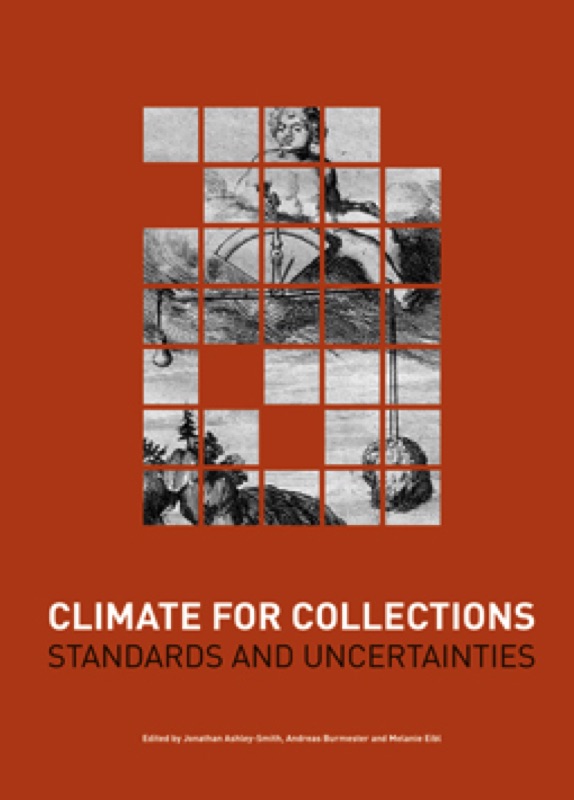The debate about environmental standards for museum collections has by no means been resolved. Climate change, ever increasing energy bills, the complexity of air-conditioning systems, the feasibility of alternative climate control strategies and the real effects of inappropriate indoor environments on collections pose major questions for conservation professionals.
The papers in this volume , given at a major international conference, held at the Pinakothek der Moderne in Munich from 7 to 9 November 2012 on the occasion of the 75th anniversary of the Doerner Institut, investigate what is known and what is not known about suitable environmental conditions for cultural heritage collections, presenting the most significant recent research on the subject. The global imperative to save energy and reduce our carbon footprint is evident. Museums and other cultural institutions are deeply implicated in these concerns as major consumers of energy, particularly those housed in modern buildings. The demand for a better understanding of the interactions between cultural heritage collections and the climate is pressing. The EU-funded research project Climate for Culture is currently investigating the influence of current and future climate change on cultural heritage objects. Serious concerns have been raised in the conservation community at recent extensions of the range of acceptable climate criteria for both permanent exhibitions and loans, and new theories such as the ‘proofed fluctuation concept’ are much discussed.
Climate for Collections Standards and Uncertainties addresses these issues. By adopting broad definitions of both ‘climate‘ and ‘collection’, the subject has been expanded beyond the concerns of previous conferences such as ‘Museum Microclimates’ (Copenhagen 2007) and recent discussions such as ‘The plus/minus dilemma’ (IIC/AIC 2010). To ensure these questions are addressed in depth, the topics of climate change and sustainability have been introduced.
A PDF of this book is online at www.doernerinstitut.de
Allowable microclimatic variations in museums and historic buildings: reviewing the guidelines
Lukasz Bratasz
Towards a common understanding of standards?
Jane Henderson and Shumeng Dai
Conservation of cultural heritage – European standards on the environment
Jesper Stub Johnsen
Collections demography: stakeholders’ views on the lifetime of collections
Catherine Dillon, William Lindsay, Joel Taylor, Kalliopi Fouseki, Nancy Bell and Matija Strlicˇ
The limits of Garry Thomson’s Museums Temperate Zone:can they be enlarged?
Luis Efrem Elias Casanovas, Vasco Peixoto de Freitas, Cláudia Ferreira and Sílvia Oliveira Sequeira
Acoustic emission monitoring: on the path to rational strategies for collection care
Michal Lukomski, Janusz Czop, Marcin Strojecki and Lukasz Bratasz
How the usual museum climate recommendations endanger our cultural heritage
Andreas Schulze
Field-tested methodology for optimizing climate management
Jeremy Linden, James M. Reilly and Peter Herzog
Evaluation of different approaches of microclimate control in cultural heritage buildings
Tor Broström, Tomas Vyhlídal, Goran Simeunovic,
Poul Klenz Larsen and Pavel Zítek
A critical look at the use of HVAC systems in the museum environment
Edgar Neuhaus
The role of historic house heating systems in collections climate control at the National Trust
Nigel Blades, Hazel Jessep and Katy Lithgow
A museum storage facility controlled by solar energy
Morten Ryhl-Svendsen, Lars Aasbjerg Jensen, Poul Klenz Larsen, Benny Bøhm and Tim Padfield
Passively conditioned zero-energy storage for cultural properties and archival material
Lars Klemm
New meets old – the requirements and limits of new collection facilities at the Museum für Naturkunde Berlin
Peter Bartsch, Christiane Quaisser, Peter Giere, Arwid Theuer-Kock and Norbert Feck
The use of underground structures as a solution towards sustainable museums in the Mediterranean basin
Dimitrios Karolidis
Sustainable climate control for art galleries? Experiences at Liverpool’s Walker Art Gallery
David Crombie, Chris Bailey, Bernard Connolly, Sonia Jones,
Siobhan Watts and Sally Ann Yates
Solutions for challenging buildings: Storage projects at the Science Museum
Marta Leskard and Louisa Burden
Learning from history. Historic indoor climate conditions and climate control strategies
Melanie Eibl and Andreas Burmester
From artwork to building preservation. Some considerations on the ‘historical’ indoor climate of Villa Reale in Milan
Andrea Luciani, Carlo Manfredi, Davide Del Curto and Luca P. Valisi
Uncertainties in the interaction between a canvas painting support and moisture
Anna von Reden
Monitoring complex objects in real display environments – how helpful is it?
Naomi Luxford and David Thickett
What real museum objects can teach us about the influence of climate conditions
Paul van Duin
The Oseberg ship. Long-term physical-mechanical monitoring in an uncontrolled relative humidity exhibition environment. Analytical results and hygromechanical modeling
Paolo Dionisi-Vici, Ottaviano Allegretti, Susan Braovac, Guro Hjulstad, Maria Jensen and Elin Storbekk
Comparison of indoor climate analysis according to current climate guidelines with the conservational investigation using the example of Linderhof Palace
Kristina Holl
Quantification, the link to relate climate-induced damage to indoor environments in historic buildings
Charlotta Bylund Melin and Mattias Legnér
Development of damage functions for copper, silver and enamels on copper
David Thickett, Rebecca Chisholm and Paul Lankester
Delivering damage functions in enclosures
Paul Lankester and David Thickett
Stuffing everything we know about mechanical properties into one collection simulation
Stefan Michalski
Climate risk assessment in museums
Marco Martens and Henk Schellen
The use of computer simulation models to evaluate the risks of damage to objects exposed to varying indoor climate conditions in the past, present, and future
Zara Huijbregts, Marco Martens, Jos van Schijndel and Henk Schellen
The application of damage functions to future indoor climate predictions
Paul Lankester, Peter Brimblecombe and David Thickett
Uncertainties in damage assessments of future indoor climates
Gustaf Leijonhufvud, Erik Kjellström, Tor Broström, Jonathan Ashley-Smith and Dario Camuffo
The influence of the museum environment in controlling insect pests
Robert Child
Inverse modeling of climate responses of monumental buildings
Rick Kramer, Jos van Schijndel and Henk Schellen
The moving fluctuation range – a new analytical method for evaluation of climate fluctuations in historic buildings
Stefan Bichlmair, Kristina Holl and Ralf Kilian
